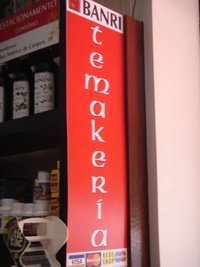1月第1週の日曜日の朝、教会へ行く途中、ジョアキン君に出会いました。ジョアキン君とは、かわいいビーグルのワンちゃんのことで、初めて会ったのは3年前でした。
「Feliz Ano-Novo!」と、わたしが新年の挨拶をすると、飼い主さんは「オメデトウ」と、丁寧におじぎまでしてくれました。わたしは、とても驚きました。普通ブラジル人は頭を下げて挨拶する習慣はありませんし、「オメデトウ」は「アリガトウ」や「サヨウナラ」程、知られていないと思っていたからです。
そして、2日後の朝、再びジョアキン君に出会いました。散歩が始ったばかりのワンちゃんは「はやく、はやく」と言いたそうな様子だったので、わたしは「Bom dia!」と言ってから、朝市に行こうとしました。すると、今度は、「オメデトウゴザイマス」と、飼い主さんが丁寧に頭を下げて言ったのです。
今回は「ゴザイマス」まで入れて、なんと気づかいのある飼い主さんなんでしょうと、わたしは感動しました。
今年初めての朝市はいつもより人出が少なかったのですが、「今年も良い年になるように」と、あちこちで皆、挨拶を交わして、楽しそうでした。
すると、誰かが「オメデトウ」と言い、ほかの誰かが「オメデトウ」と答えるやりとりが聞こえ、そちらへ振り向いてみました。すると、ふたりとも非日系人です!あたりまえのように日本語を混ぜた会話でした。
このシリーズの「オハヨウ・ボンディア」というタイトルは、日系人とブラジル人の間で生まれた会話が由来だったのです。
約20年前のことでした。同じアパートに住んでいたおばちゃんとエレベーターで会って、わたしは「Bom dia!」と挨拶すると、イタリア系の青い目のおばちゃんは微笑んで「オハヨウ」と言いました。そのとき「オハヨウ・ボンディア」という言葉が頭に浮かびました。それ以来、「オハヨウ・ボンディア」はわたしのトレードマークです。
最近になって、ようやく、日本の言葉の一部が一般ブラジル人に受け入れられていることを嬉しく思っています。
簡単に同様な言葉のリストを作ってみたところ、食べ物に関する言葉が多いことに気が付きました。「ヤキソバ」、「テンプラ」、「スシ」、「スキヤキ」などは最もブラジル人に知られていると思います。
一方、「ショウユ」と「トウフ」は微妙なアクセントで発音され、「ショユー」、「トフー」に聞こえますが。
インスタントラーメンは一般に広く人気がありますが、「ラーメン」の代わりに、メーカーの名前である「Miojo」と一般的に言われています。先日、若い女性が着ていたTシャツに目が留まりました。「Eu só sei fazer miojo」「わたしは『Miojo』のほか何も出来ません」と、書かれていました。
「手巻き」や「蕎麦」や「炉辺焼き」も、最近、ブラジル人の間で人気になっているので、「テマケリア」や「ソバリア」や「ロバタリア」という専門店も見られるようになりました。日本語の「テマキ」や「ソバ」や「ロバタ」にポルトガル語の語尾「リア」を加え、新しい言葉が生まれました。
しかし、面白いこともあります。あるメーカーが座布団を「フトン」として雑誌やネットで宣伝しています。どう見ても、りっぱな座布団ですが。
どうも納得がいかないので、「futon」についてインターネットで検索してみると、結果は驚きの連続でした!なんと10数件の店やメーカーを見つけました。幾つかのサイトを調べてみますと、「futon」と言う名前でいろいろな商品が販売されていることが分かりました。
大体このように分けられています。1) Colchão futon (布団のような マット)2) Sofá-cama futon (布団のようなソファーベッド) 3) Almofada futon (布団のようなクッション) 4) Futonete (薄いマット) 5) Futon turco (縁取りのしてある布団)。
日本語の「布団」がこのように、分類されて、ブラジル人の日常生活に入り込んでいるとは、想像もしませんでした!
© 2014 Laura Honda-Hasegawa






